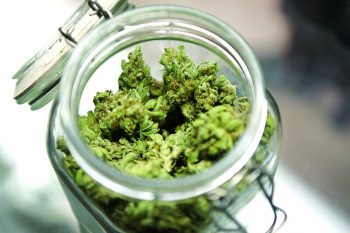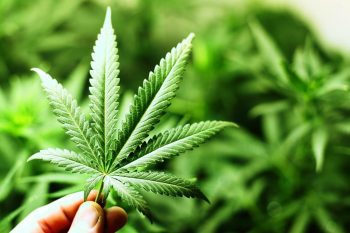By Luka
Guest writer for Wake Up World
When I finished digging through countless studies dealing with health benefits of weed, I only had one question in mind — why are we not using medical cannabis products instead of regular supplements?
In a culture where non-organic multi-vitamins are being mindlessly used (in boatloads) as a “ground breaking prevention for all diseases”, we have decided to limit the public’s access to one thing that actually works.
Even though we’ve heard a lot of bad things about weed in the last 50-70 years, nowadays, after successful efforts by many of its activists, marijuana is believed to help with up to 24 medical conditions.
To confirm this, I went over hundreds of studies and found that there are 16 biggest health benefits of weed that can be backed up by science.
Here are the real effects of cannabis on the human body:
16 scientific benefits of weed
Cannabis has been extensively used in medicine probably since before 2737 BC, when the ancient emperor Shen-Nung first depicted it as a cure for gout. Since then, there have been many claims of just how good this plant is for general health, and consequently, there have also been many studies proving and disproving these hypotheses. In this guide, we will explore the research behind the many claimed health benefits of weed.
1. Cannabis relieves neuropathic pain
For a long time, cannabis was suspected to have positive effects on patients with peripheral neuropathy.
And there’s a lot of people who suffer from this: diabetes and HIV patients are just some of the more common groups.
So you can see why this one is important.
A study from University of California analyzed the effects of smoked cannabis on 16 HIV patients suffering from painful neuropathy. Amazingly, 10 out of 16 participants reported more than 30% of pain reduction after just 7 days of smoking medicinal cannabis. (1)
According to a report published in 2012, CBD is the main cannabinoid for treating neuropathic pain, as it reduces the inflammatory response and binds to TRPV1 receptors, which are capable of mediating antihyperalgesic effects. (2)
2. Cannabis helps relieve chronic pain issues
Throughout history, cannabis has been used for treating pain and inflammation. However, pain is so complex that its correlation with cannabis cannot be handled through a couple of short-term studies.
This topic, alone, requires hundreds of studies, but a thousand mile journey must begin with a first step.
As it was noted in a 2004 research on 34 patients with chronic pain, extracts which contained THC proved the most effective in controlling pain-related symptoms. (3)
Here’s what the study concluded:
“THC and THC:CBD were effective in relieving pain and improving sleep on a small group of patients.”
However, a 2009 systematic review of cannabis treatment for chronic pain analyzed 18 clinical trials that dealt with this topic and concluded that, while cannabis treatment is efficacious for treatment of chronic pain, its beneficial effects may be jeopardized by potentially harmful side effects. (4)
As you know, THC produces psychoactive effects which not many chronic pain sufferers are keen on experiencing.
To be honest, I scrambled the web trying to find more studies dealing with the effects of cannabis on pain and then I just dropped everything and decided to look for opinions of real people:
One group claims that weed just distracts from pain:
While another group does find actual relief:
So, combined with studies and the people’s opinion, we can safely say that cannabis may be a good treatment option for chronic pain patients — whether through pain relief or just distraction, depending on the person.
But the most important thing to consider here is to not go overboard:
Strains with equal amounts of THC and CBD are probably be the best solution for treating pain, as the health benefits of cannabinoids multiply when they’re combined than when they are isolated.
3. Cannabis decreases anxiety, but only in low to moderate doses
In a study from 2011, a team of researches from Brazil’s University of São Paulo set about to explore the effects of cannabinoids (THC and CBD) on people with Generalized Social Anxiety Disorder.
They found that CBD treatment (a non-psychoactive compound of cannabis) significantly reduced anxiety and cognitive impairment of the test group. (5)
But, when it comes to stoners sharing wisdom, some say that weed induces anxiety and others that it relieves it.
So, what’s the actual truth?
Both.
If a beginner user consumes, for example, half a gram of a high-THC strain at once, he or she is likely to get extremely anxious and paranoid.
On the other hand, if the same user goes for a strain with low-THC and medium-to-high CBD content, then the paranoia is unlikely to happen, simply because CBD counteracts the “high” caused by THC. Only then does the anxiety-relief kick in.
Reducing anxiety with medical cannabis is largely a matter of finding a right strain and then figuring out the dosage, which is rather subjective and should be determined after self-experimenting with different dosages and strains.
You can find high quality CBD in whole-plant extract cannabis oils or strains high in CBD. Just make sure to keep it moderate at first and work your way up to the perfect dose.
4. Cannabis has anti-depressive properties
It’s not a secret that weed smokers are happy people. And that is due to two things:
- The high that the plant produces once we smoke it
- A chemical compound in cannabis that has anti-depressive properties
OK, so the first one is obvious but when it comes to the latter, there are a few possible explanations.
The first study I will reference was published by the British Journal of Pharmacology in 2010, which states that CBD induces antidepressant-like effects, which can be compared to a drug called Imipramine. (6)
If you’re not familiar with it, Imipramine is a tricyclic antidepressant which is given to patients with major depression and, like other strong drugs, has quite a bit of side effects.
So as this study points out, cannabis strains with higher doses of CBD seem like a perfect alternative, especially because they do not produce euphoria and psychoactive effects.
If you’re concerned whether cannabis may cause depression, don’t be.
According to an integrative data analysis study published in 2012, which studied 6,900 subjects between adolescence and mature adulthood, there is no apparent link between cannabis use and depression. (7)
5. Cannabis relieves craniofacial pain
Craniofacial pain is, in some respect, similar to other types of pain that I mentioned earlier but is different in its location.
This type of pain is chronic and is limited to the head and neck area. It is mostly caused by dental problems, anxiety and TMD — Temporomandibular Joint Dysfunction.
Even though scientists have confirmed, through various studies, that cannabis does actually relieve neuropathic pain, craniofacial pain didn’t receive that much research.
However, I dug up a study from 2004 that tackled this issue and found that weed indeed may be beneficial for this type of pain. (8)
As they’ve put it:
“These results indicate that cannabinoid receptor agonists may be effective agents for craniofacial pain.”
Translated into plain English, substances (read: THC) that activate cannabinoid receptors (read: CB1 and CB2), may treat this particular type of pain.
6. Cannabis helps HIV patients relieve side effects of their therapy
There are actually plenty of studies that examine the use of cannabis in HIV patients.
The biggest study I could find is a research of 252 patients, conducted by the San Mateo Medical Center. The subjects were asked very specific questions concerning their perceived benefits of consuming weed.
Here is what they said weed helps them with (9):
- Relieving anxiety and depression
- Improving appetite
- Relieving pain
- Increasing pleasure of life
This study concluded that we need to continue the research into how cannabis can improve the quality of life of HIV patients.
I have to say that the overall outlook is positive and that cannabis does seem like a useful addition to standard HIV therapy.
7. Cannabis has anti-inflammatory properties
Cannabinoids have also been extensively researched for their anti-inflammatory properties.
One particular publication from 2009 claims that administration of cannabinoids can be a potent treatment against inflammatory disorders. According to the study, using exogenous cannabinoids (for example, from marijuana) can constitute a potent treatment modality against inflammatory disorders.
The study concluded that “administration of THC into mice triggered programmed cell death in T cells and dendritic cells, resulting in immunosuppression”. (10)
Several studies have also confirmed that CBD regulates immune system response as well. (11)
Just think about this for a second:
These findings mean that CBD could be a valid treatment option for people suffering from various inflammatory disorders, such as Crohn’s Disease, Familial Mediterranean Fever (FMF), arthritis, lupus, Hashimoto’s disease and many more.
As the research of cannabis progresses, so will the knowledge of the doctors who treat patients with these types of illnesses.
8. Cannabis regulates fat cell metabolism, on a smaller scale
According to a study done in 2005 by the University of California, Oleoylethanolamide (OEA) regulates metabolism of fat cells and therefore produces anti-obesity properties. (12)
OEA is a lipid that activates a nuclear receptor called PPAR.
When you consume cannabis, cannabinoids stimulate your endogenous cannabinoid receptors (CB1 and CB2), which stimulate the production of OEA. OEA then activates PPAR to regulate feeding and stimulate fat utilization.
Without going too much into Walter White mode (because trust me, I’m struggling here a bit as well) all of this happens on a cellular level.
Unfortunately for us, there are many factors that go into whole body fat loss, so don’t expect to sit around on a couch all day, smoke weed and get shredded.
9. Cannabis regulates blood pressure
So far you’ve got the idea that cannabis stimulates our very own endocannabinoid system, which regulates hundreds of physiological processes.
Laboratory of Physical Studies from the National Institute of Health published a report which concluded that cannabinoids have powerful hypotensive effects, which they achieve through complex processes involving myocardium and vasculature. (13)
That being said, I would advise not to attempt to regulate blood pressure with cannabis as getting the dosage right is extremely difficult for many novice users and taking too much weed could induce unwanted paranoia and heart palpitations.
10. Cannabis protects the brain cells
Cannabinoids, as compounds, are proven to have neuroprotective properties.
This topic was explored in a 2005 study, which found that two CB1 activators significantly reduced hippocampal cell death and that “cannabinoids prevent cell death by initiating a time and dose dependent inhibition of adenylyl cyclase.” (14)
The main cannabinoid, when it comes to protecting the good old brain cells, is CBD, which has been proven to reduce short-term brain damage and was associated with extracerebral benefits. (15)
11. Cannabis is proven to relieve spasms in MS patients
Multiple Sclerosis is an extremely difficult disease that has no apparent cure. It basically inflames the entire neurological system and causes painful and debilitating muscle spasms. Around 90% of MS patients develop muscle spasticity.
My friend from college actually has MS and I remember that she said, on multiple occasions, how weed is currently the only thing that helps her relax and unwind. So that’s why I wanted to dig a bit deeper into this.
In their book called “Marijuana as Medicine”, Alison Mack and Janet E. Joy reviewed the health effects of marijuana on many different medical conditions, proving once again just how wide the application of cannabis is. (16)
One particular chapter deals with the effects of cannabis on muscle spasticity, citing two promising patient surveys:
- In a 1982 survey of 43 people with spinal cord injuries, 50% of respondents reported that marijuana reduced muscle spasticity.
- In a 1997 survey of 112 MS patients who use cannabis in conjunction with their therapy, 97% reported that cannabis improved spasticity, chronic pain, tremor, weight loss and other symptoms. (17)
To further supplement these findings, I consulted Dr. Mechoulam’s (the man who basically discovered THC) paper called “Cannabinoids in health and disease”, which states that the combination of THC and CBD lowers the frequency and intensity of muscle spasms in MS patients. (18)
Couple that with marijuana’s ability to reduce pain, and you have an organic supplement to MS therapy.
12. Cannabis is useful as a short-term appetite booster
You probably heard (or experienced) the term munchies — you smoke some weed and then, all of a sudden, you feel like you could eat an elephant (not that you would, actually).
Well, it turns out that this is useful for treating side-effects of medical conditions where patients are underweight, such as HIV or cancer.
Cannabinoids play an important role in regulating feeding behaviors in all mammals.
The main group of cannabinoid receptors, CB1, are located in both the brain and stomach, and stimulating these receptors signals to our brain that the stomach is empty and that we need to eat. Cannabinoids found in marijuana (largely THC) are able to stimulate these very same receptors, which can produce a feeling of “I need to eat right now”, even though you might’ve just finished eating.
13. Cannabis relieves nausea and vomiting
Nausea is a common side effect of many illnesses and their treatments — cancer and HIV/AIDS are among the top causes.
So it’s no wonder why medical cannabis was subjected to nausea-related research very early on.
The first and the only study I’m going to cite was published by the Hebrew University Medical Faculty in 2002, and it essentially explains how CBD may have therapeutic value in treating nausea caused by chemotherapy. (19)
14. Cannabis decreases frequency of chronic migraines
I was pretty stoked for this one as I used to suffer from chronic headaches when I was a kid.
A recent study from 2016 researched the effects of cannabis on migraines and concluded that the frequency of migraine headache was decreased with medical marijuana use. (20)
A total of 121 subjects were involved in the study and besides reporting decreased migraine frequency , unbelievably, 11% reported complete resolution of headaches.
The study does not state which THC and CBD percentages were used in the research, but it does address the fact that edibles caused more side-effects for this group of patients than other forms of cannabis.
15. Cannabis relieves epileptic seizures
Cannabis got recognized for successfully treating seizure disorders after being the main topic of a 2013 CNN documentary, which explored how parents of a five-year-old girl called Charlotte Figi successfully treated her epilepsy with high CBD cannabis.
There are a lot of people with epilepsy who are treating their condition with medicinal cannabis. And that includes parents who are trying to help their kids.
In 2013, a group of researchers from Stanford University published a study containing a survey of parents whose kids have epilepsy.
The interviewed parents reported extremely high rate of success in reducing seizure frequency and severity. (21)
Interestingly, they were using CBD-rich cannabis products to accomplish that.
16. Cannabis inhibits tumor growth
I saved the best for last.
Cannabis has been scientifically proven to inhibit tumor cell growth on rodent and human cells (Petri dish) — but it has yet to be officially confirmed through in vivo testing.
However, the overall public opinion on this is that cannabis does indeed help with treating certain tumors and cancers. Just look at Rick Simpson’s inspiring story.
One part of that can be attributed to weed’s ability to reduce side effects of cancer therapy.
The second part is a bit controversial but still very significant:
An international team of scientists researched the effects of THC on cancer cells and concluded that the compound actually does destroy cancer cells by stimulating autophagy — a process which promotes cell death. (22)
But the most unbelievable bit is their official conclusion:
“These findings describe a mechanism by which THC can promote the autophagic death of human and mouse cancer cells and provide evidence that cannabinoid administration may be an effective therapeutic strategy for targeting human cancers.”
Whether this will be confirmed in vivo, we just have to wait and see.
References:
- Abrams DI, Jay C, Petersen K, Shade S, Vizoso H, Reda H, Benowitz N, Rowbotham M; The Effects of Smoked Cannabis in Painful Peripheral Neuropathy and Cancer Pain Refractory to Opioids; International Association of Cannabis as Medicine, Cologne; 2003, p.28.
- Xiong W, Cui T, Cheng K, Yang F, Chen SR, Willenbring D, Zhang L; Cannabinoids suppress inflammatory and neuropathic pain by targeting ?3 glycine receptors; The Journal of Experimental Medicine; 209(6):1121–1134.
- Notcutt W, Price M, Miller R, Newport S, Phillips C, Simmons S, Sansom C; Initial experiences with medicinal extracts of cannabis for chronic pain: Results from 34 ‘N of 1’ studies; Anaesthesia; 2004; 59: 440-452.
- Eva Martín-Sánchez, Toshiaki A. Furukawa, Julian Taylor, Jose Luis R. Martin; Systematic Review and Meta-analysis of Cannabis Treatment for Chronic Pain; Pain Medicine; November 2009; 10(8):1353-68.
- Bergamaschi MM, Queiroz RH, Chagas MH, de Oliveira DC, De Martinis BS, Kapczinski F, Quevedo J, Roesler R, Schröder N, Nardi AE, Martín-Santos R, Hallak JE, Zuardi AW, Crippa JA; Cannabidiol Reduces the Anxiety Induced by Simulated Public Speaking in Treatment-Naïve Social Phobia Patients; Neuropsychopharmacology; May 2011; 36(6):1219–1226.
- Zanelati TV, Biojone C, Moreira FA, Guimarães FS, Joca SR; Antidepressant-like effects of cannabidiol in mice: possible involvement of 5-HT1A receptors; British Journal of Pharmacology; January 2010; 159(1):122–128.
- Horwood LJ, Fergusson DM, Coffey C, Patton GC, Tait R, Smart D, Letcher P, Silins E, Hutchinson DM; Cannabis and depression: An integrative data analysis of four Australasian cohorts; Drug and alcohol dependence; December 2012; 126(3):369-78.
- Papanastassiou AM, Fields HL, Meng ID. Local application of the cannabinoid receptor agonist, WIN 55,212–2, to spinal trigeminal nucleus caudalis differentially affects nociceptive and non-nociceptive neurons; Pain; 107(3):267-75.
- Prentiss D, Power R, Balmas G, Tzuang G, Israelski DM; Patterns of marijuana use among patients with HIV/AIDS followed in a public health care setting; Journal of Acquired Immune Deficiency Syndromes; January 2004; 35(1):38-45.
- Nagarkatti P, Pandey R, Rieder SA, Hegde VL, Nagarkatti M; Cannabinoids as novel anti-inflammatory drugs; Future Medicinal Chemistry; October 2009; 1(7):1333-1349.
- Leinow L, Birnbaum J; CBD: A Patient’s Guide to Medicinal Cannabis; North Atlantic Books; October 2017
- Fu J, Oveisi F, Gaetani S, Lin E, Piomelli D; Oleoylethanolamide, an endogenous PPAR-? agonist, lowers body weight and hyperlipidemia in obese rat; Neuropharmacology; 48(8):1147-53.
- Pacher P, Bátkai S, Kunos G; Blood pressure regulation by endocannabinoids and their receptors; Neuropharmacology; Jun 2005; 48(8):1130–1138.
- Zhuang SY, Bridges D, Grigorenko E, McCloud S, Boon A, Hampson RE, Deadwyler SA; Cannabinoids produce neuroprotection by reducing intracellular calcium release from ryanodine-sensitive stores; Neuropharmacology; Jun 2005; 48(8):1086-96.
- Alvarez FJ, Lafuente H, Rey-Santano MC, Mielgo VE, Gastiasoro E, Rueda M, Pertwee RG, Castillo AI, Romero J, Martínez-Orgado J; Neuroprotective Effects of the Nonpsychoactive Cannabinoid Cannabidiol in Hypoxic-Ischemic Newborn Piglets; Pediatric Research; December 2008; 64(6):653-8.
- Mack A, Joy J; Marijuana as Medicine? The Science Beyond the Controversy; Washington (DC): National Academies Press (US); 2000.
- Consroe P, Musty R, Rein J, Tillery W, Pertwee R; The Perceived Effects of Smoked Cannabis on Patients with Multiple Sclerosis; European Neurology; 1997; 38(1):44-8.
- Kogan MN, Mechoulam R; Cannabinoids in health and disease. Dialogues in Clinical Neuroscience; 2007; 9(4):413–430.
- Parker LA, Mechoulam R, Schlievert C; Cannabidiol, a non-psychoactive component of cannabis and its synthetic dimethylheptyl homolog suppress nausea in an experimental model with rats; NeuroReport April 2002; 13(5):567-70.
- Rhyne DN, Anderson SL, Gedde M, Borgelt LM; Effects of Medical Marijuana on Migraine Headache Frequency in an Adult Population; Pharmacotherapy, May 2016; 36(5):505-10.
- Porter BE, Jacobson C; Report of a parent survey of cannabidiol-enriched cannabis use in pediatric treatment-resistant epilepsy; Epilepsy & Behavior?; December 2013; 29(3):574–577.
- Salazar M, Carracedo A, Salanueva IJ, Hernández-Tiedra S, Lorente M, Egia A, Vázquez P, Blázquez C, Torres S, García S, Nowak J, Fimia GM, Piacentini M, Cecconi F, Pandolfi PP, González-Feria L, Iovanna JL, Guzmán M, Boya P, Velasco G; Cannabinoid action induces autophagy-mediated cell death through stimulation of ER stress in human glioma cells; The Journal of Clinical Investigation; May 2009; 119(5):1359-1372.
About the author:
Luka is Editor in chief at Greencamp. Into all kinds of technical tutorials and topics related to cannabis culture. Professional at postponing workouts.
For more, visit greencamp.com and facebook.com/greencamphq.

If you've found value in our articles, we invite you to support the release of our brand-new book, "Gratitude Practices for Kids: A Practical Guide for Adults to Instill a Spirit of Appreciation and Positivity in the Next Generation."
"Gratitude Practices for Kids" brings together over 25 innovative and accessible practices designed to enhance gratitude in everyday life. This comprehensive guide is backed by 17 scientific studies, ensuring each concept is grounded in research, underscoring our commitment to nurturing growth, emotional intelligence, and positive interactions between adults and children.
We encourage you to opt for the paperback version to celebrate this new release. Dive into its fresh pages away from digital distractions, allowing you to immerse yourself in the transformative practices it offers.
Over recent years, Wake Up World has faced significant online censorship, which has impacted our financial ability to operate. Moving into book publishing represents a strategic step to secure the ongoing funds needed to continue our mission. By purchasing Gratitude for Kids, you help us keep our content free and accessible to everyone, avoiding needing a paywall. With over 8,500 articles published in the last 13 years, we remain dedicated to keeping our valuable content open to all.













